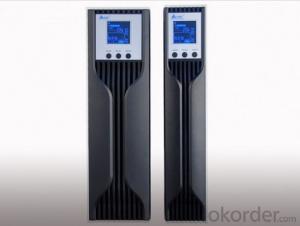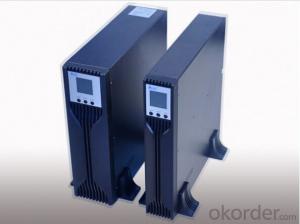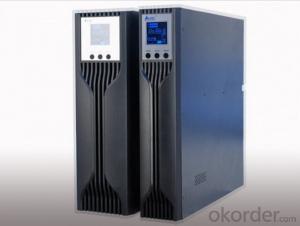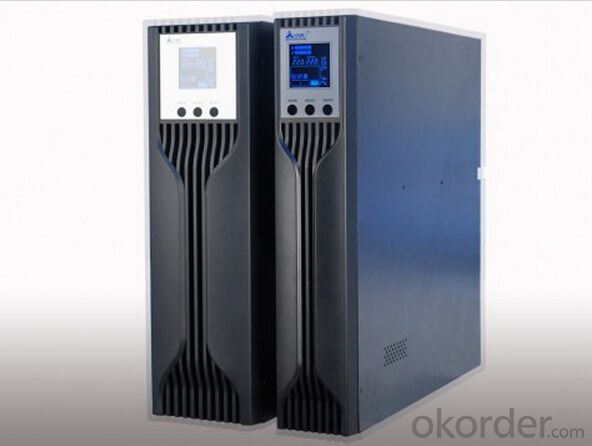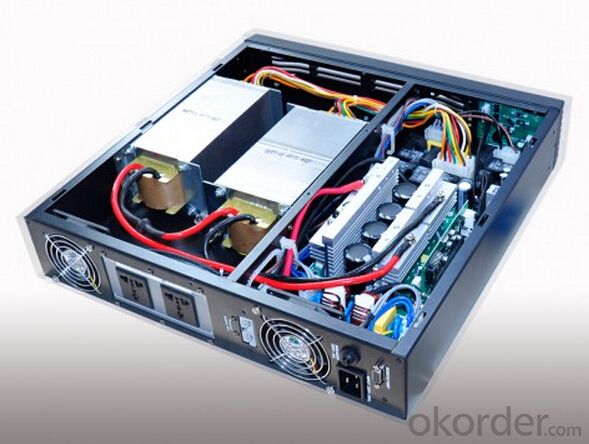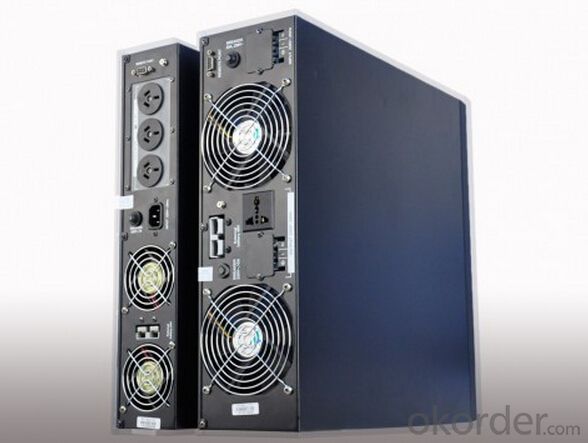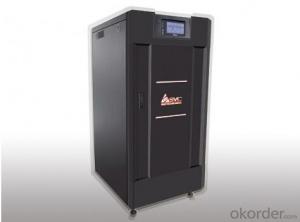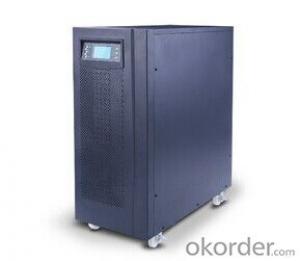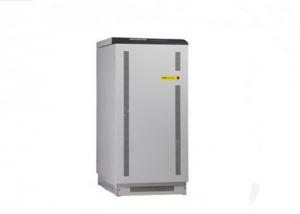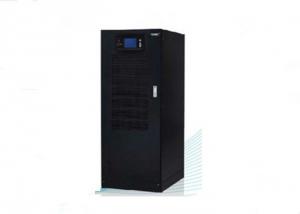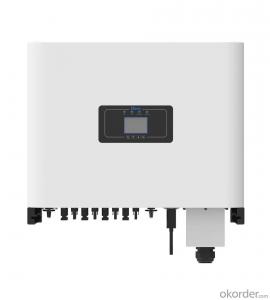Ingeteam Solar Inverter 20~30kVA Online Low Frequency 3 in 3 out Double Conversion UPS
- Loading Port:
- Guangzhou
- Payment Terms:
- TT OR LC
- Min Order Qty:
- 30 unit
- Supply Capability:
- 300000 unit/month
OKorder Service Pledge
OKorder Financial Service
You Might Also Like
20~30KVA Online Low Frequency 3 in 3 Out Double Conversion UPS

1. Wide range of input voltage
The UPS can offer normal and stable service voltage under its input voltage range. When the input voltage is out of its range the machine will switch to battery mode automatically to keep the output power in order to protect the equipment, such as computers, ensure they will not be damaged by the over high or over low voltage, users can continue the operation of equipment for a while or save the data on computers while the power network is abnormal.
2. Wide range of AVR(Automatic voltage regulation)
In the product’s input voltage range and under 3 steps of intelligent AVR function, it can provide a stable output voltage.
3. Automatic self detection when UPS on(LED).
Before the UPS on, red, yellow, blue LED will light up two times by cycle turns, after self detection UPS switch to AC mode/battery mode or working mode.
4. Silence function
In the "battery mode", shortly press the switch to turn off the buzzer. But the battery is about to run out or the load is too heavy, the buzzer sound cannot be muted.
5. Overload protection
In the battery mode, output voltage turn down correspondingly when it is overload, after the capacity of load is lower than the rated power then output voltage will back to rated value, it ensures the UPS will not shut down by abrupt overload which caused by surging current during the computer is working and other equipment is added.
6. Short circuit protection
When the mis-operation caused the load short circuit or computer failure (such as power tube breakdown of switch) cause short circuit, the UPS will shutdown automatically for protection.
7. The low current switch
This UPS adopts low current switch to extend the service life which is longer than conventional battery and high current switch in AC current path.
8. Automatic charging
There are two charging mode, charging time is faster than ordinary charging mode, higher efficiency, and greatly prolonging the service life of the battery.
9. With a bypass output
Independent bypass output socket for external printers or scanners of computer peripherals, with surge protection of the load.
| MODEL | GP33-20-30 | GP33-40-60 | GP33-80-100 | GP33-120-200 |
| Capacity | 20~30KVA | 40~60KVA | 80~100KVA | 120~200KVA |
| Type | Tower | |||
| INPUT | ||||
| Voltage | (208 or 380 or 400 or 480 Vac) ± 20% / 5 wires (3 Lines + Neutral + Ground) | |||
| Frequency | 50 or 60Hz ± 10% Autosensing | |||
| Power factor | 0.98 | |||
| Filter | EMI, RFI | |||
| Dual input | Optional | |||
| OUTPUT | ||||
| Voltage | (208 or 380 or 400 or 480 Vac) ± 20% / 5 wires (3 Lines + Neutral + Ground) | |||
| Frequency | 50 or 60Hz ± 0.1% | |||
| Effciency | AC / AC > 92% | |||
| Trandfer time | 0 ms | |||
| Wave form | Sine wave | |||
| Power factor | 0.9 | |||
| Voltage T.H.D. | < 2% with linear load< td=""> | |||
| Crest factor | 3 : 1 | |||
| Technology | True on-line double conversion controlled by microcontroller | |||
| Overload recovery | Automatically transfer to UPS mode | |||
| Isolation transformer | Inverter mode ( bypass mode is optional ) | |||
| Parallel connection | Parallel connection function is ready (extra PCB is not required ) | |||
| BATTERY | ||||
| Battery type | VRLA ( Valve Regulated Lead Acid ), not included | |||
| DC voltage | 384 Vac | 480 Vdc | ||
| Charging time | 4 hours up to 90% | |||
| Battery detection | self-detect, transfer to battery mode adjustable | |||
| PROTECTION | ||||
Lighting and transient protection | Hotswappable lightning and transient surge suppressor (In:10 Kamp, Up:1.5 Kv, I max : 20 K amp. ) | |||
| Hardware protection | output breaker, battery breaker, bypass breaker; DC fuse, fan, redundant power supply; temperature sensor, EPO (Emergency Power Off), audible alarms etc. | |||
| Software protection | Discharging batteries, battery charge working mode, inverter working mode, emergency power off, manual shutdown, bypass SCR failure, bypass sequence failure, bypass over the lilit, critical overload, batteries exhaustion, low or high output voltage, DC fuse open, 5v power supply failure, 13.5V power supply failure, inverter overvoltage, 200% overload on each line, transfer failure, inverter voltage out of range, over voltage between neutral and ground, UPS on bypass mode, bypass frequency out opf range. | |||
| Bypass | Solid state | |||
| Overload | 125% for 10 min, 150% for 30 sec, 1000% for 16 millisencond. | |||
| EPO | EPO local and / or remote | |||
| Display | LCD, touch screen | |||
| LED's diagram | Included | |||
| Communication | RS232 intellident Slot, modem, SNMP(RJ45) (SNMP adaptive Software is supplied by the producer) | |||
| ENVIRONMENT | ||||
| Elevation | 1.700 m.o.s. 1 without derrating | |||
Temperature & noise | 0℃~40℃ / < 60db @ 1.5m.< td=""> | |||
| Humidity | Non condensate | |||
| PHYSICAL | ||||
| Dimension(mm) | 520*1600*550 | 520*1670*780 | 1000*1860*870 | Ask for information |
Weight (without batteries) | 150 | 300 | 600 | |

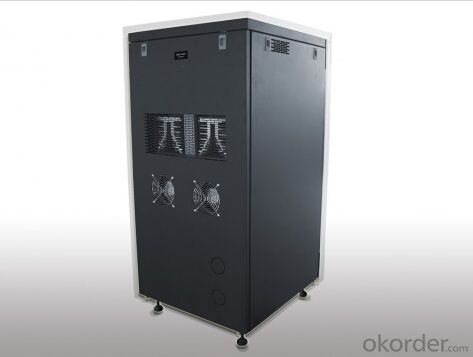

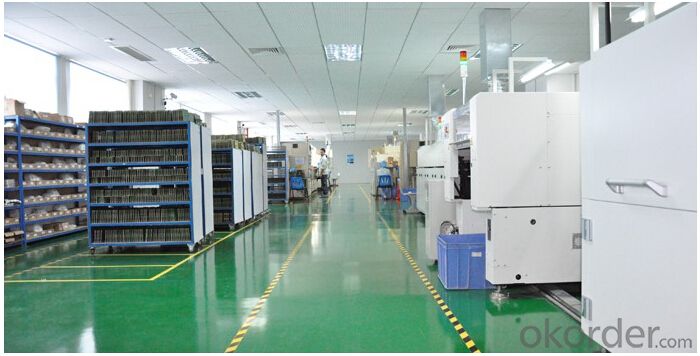
FAQ
1. Where can I buy your products?
You could find our products from dealers or contact our sales team directly. We will provide you with detailed services.
2. How to contact us?
Contact details can be found from website www.okorder.com to contact us. We look forward to providing you with professional services.
3. What is the application field of your products?
Our current GW1500~4600-SS series and GW3000~4600-DS, with the flexible expansion ability and allocation capability, can be used in the small photovoltaic (PV) grid power generation systems of family units as well as the commercial photovoltaic system such as BIPV, BAPV and etc.
4. What kinds of modules do your inventers support?
Our inventers support most of mainstream components and modules in the market. Should you require more details, please do not hesitate to contact our technical personnel.
- Q: How does a solar inverter affect the overall system cost?
- A solar inverter affects the overall system cost by adding to the initial investment required for installing a solar power system. Inverters are an essential component in converting the DC electricity produced by solar panels into usable AC electricity for our homes or businesses. The cost of a solar inverter depends on its capacity, brand, and features. While inverters do add to the overall system cost, they are crucial for efficient energy production and can enhance the system's performance and longevity.
- Q: Can a solar inverter be used in areas with frequent power outages?
- Yes, a solar inverter can be used in areas with frequent power outages. Solar inverters are designed to convert the direct current (DC) electricity generated by solar panels into alternating current (AC) electricity that can be used to power household appliances and electronics. In the event of a power outage, a solar inverter can continue to supply electricity to the connected loads, provided that the solar panels are receiving sunlight. However, it is important to note that a solar inverter alone may not provide a constant power supply during extended power outages unless it is paired with a battery storage system.
- Q: How does a solar inverter handle grid synchronization during startup?
- During startup, a solar inverter handles grid synchronization by first ensuring that the grid is stable and within acceptable voltage and frequency ranges. It then synchronizes its output voltage and frequency with the grid by monitoring its phase angle and adjusting it accordingly. This synchronization process allows the solar inverter to safely and seamlessly connect to the grid, ensuring smooth power transfer and operation.
- Q: Can a solar inverter be used with a ground-mounted solar array?
- Yes, a solar inverter can be used with a ground-mounted solar array. In fact, ground-mounted solar arrays are commonly used with solar inverters to convert the direct current (DC) generated by the solar panels into alternating current (AC) that can be used to power homes and buildings.
- Q: How does a solar inverter handle variations in solar irradiation?
- A solar inverter handles variations in solar irradiation by continuously monitoring the amount of sunlight received from the solar panels. It adjusts its power output accordingly to convert the maximum available DC power from the panels into AC power for use in the electrical grid or home. This dynamic response ensures that the inverter optimizes energy production even during changing weather conditions or fluctuations in solar irradiation.
- Q: Can a solar inverter be used with solar-powered security systems?
- Yes, a solar inverter can be used with solar-powered security systems. A solar inverter is responsible for converting the DC power generated by solar panels into AC power that can be used to power various electrical devices, including security systems. By using a solar inverter, solar-powered security systems can efficiently utilize the energy generated by solar panels to operate effectively.
- Q: How long does a solar inverter last?
- A solar inverter typically lasts between 10 to 20 years, depending on various factors such as quality, usage, maintenance, and environmental conditions.
- Q: Can a solar inverter be used in regions with high levels of electromagnetic interference?
- Yes, a solar inverter can be used in regions with high levels of electromagnetic interference. However, it is important to ensure that the solar inverter is designed and manufactured to have proper electromagnetic compatibility (EMC) measures in place. These measures help to minimize the impact of electromagnetic interference on the operation and performance of the solar inverter.
- Q: Can a solar inverter be used off-grid?
- Yes, a solar inverter can be used off-grid. Off-grid systems typically include a solar panel array, a charge controller, batteries for energy storage, and an inverter to convert the stored DC (direct current) electricity from the batteries into AC (alternating current) electricity for use in off-grid applications. The inverter plays a crucial role in converting the DC power from the solar panels or batteries into usable AC power, making it possible to power various appliances and devices off-grid using solar energy.
- Q: How does a solar inverter handle reactive power injection into the grid?
- A solar inverter manages reactive power injection into the grid through the use of power factor control techniques. It adjusts the phase relationship between the voltage and current to ensure that the power factor remains within acceptable limits. This is achieved by either absorbing or injecting reactive power as needed, helping to stabilize the grid and improve overall system efficiency.
Send your message to us
Ingeteam Solar Inverter 20~30kVA Online Low Frequency 3 in 3 out Double Conversion UPS
- Loading Port:
- Guangzhou
- Payment Terms:
- TT OR LC
- Min Order Qty:
- 30 unit
- Supply Capability:
- 300000 unit/month
OKorder Service Pledge
OKorder Financial Service
Similar products
Hot products
Hot Searches
Related keywords
